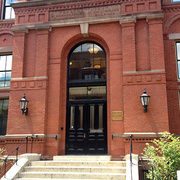
Dear Members of the Peabody Community,
Founded in 1866, the Peabody Museum is intricately linked to 19th-century legacies of settler colonialism and imperialism both in the United States and around the globe. In its development as a premier research and teaching institution, the Peabody directly benefited from collecting practices that we recognize today ignore the wishes and values of families and communities, particularly people considered to be outside of western traditions.We must confront the difficult truth that this legacy is embedded within the entire history of the Museum. Collecting—at the Peabody and elsewhere—drove the removal of human remains and cultural materials from communities of origin, creating, for example, one of the largest collections of American Indian remains in the country. These legacies are with us today, present in the language used to document collections, in past exhibitions, and in the ways collections have been used in teaching and research.
As part of a Museum-wide focus on ethical stewardship and Harvard University’s aim to understand and address the historical and enduring connections to the legacy of slavery, we have examined Museum records for individuals who are identified as African American or of African descent and whose associated geographical information places them within the United States. As Harvard University President Larry Bacow announced today, we have identified human remains of fifteen individuals of African descent who were or were likely to have been alive during the period of American enslavement.
This revelation reminds us of the breadth and reach of the legacies of the Museum’s history, and of our ethical responsibilities to affected communities, including those focused on the thousands of Native American individuals within the collection and the Museum’s work under the Native American Graves Protection and Repatriation Act (NAGPRA). In both size and scope, the Peabody cares for one of the largest collections subject to NAGPRA, which, before the legislation was passed, included remains from more than 10,000 individuals, and still includes 7,000 individuals today. A year ago, Edgerley Family Dean of the Faculty of Arts and Sciences Claudine Gay, appointed a NAGPRA Advisory Committee to support the Museum’s long-term commitment to the implementation of NAGPRA and the ethical and moral imperative it represents. This committee, as well as our Faculty Executive Committee, looks forward to joining the work of the University’s new steering committee on human remains chaired by Professor Evelynn Hammonds, who is a member of our Faculty Executive Committee.
The Peabody, alongside President Bacow, apologizes without equivocation for not confronting our historic collecting practices and stewardship of all of these human remains and for our failure as an institution to face the ethical and moral issues that undergirded the practices that brought them to our Museum. In 1990, when NAGPRA was passed, our Museum should have issued a formal apology. Today, we take the occasion of this current discovery and this wide-ranging institutional apology, to make a specific and formal apology for the practices that led to the Peabody’s large collection of Native American human remains and funerary objects.
We pledge to prioritize the urgent work of understanding and illuminating our history and to begin to make amends. As part of our focus on ethical stewardship, the Museum has begun a new collaborative, multi-year, cross-departmental initiative to critically examine our institutional history. We want to engage, with focus and urgency, our teaching and research mission through collections research, offering a new undergraduate class, and assessing our historic documentation, among other activities.
This effort is only the first step in a much longer and ongoing process of repairing the harm that historic collection practices have perpetrated. The Museum will be an active participant in the University’s new steering committee on human remains. With regard to the fifteen individuals named in President Bacow’s announcement, the Museum is already engaged in learning more about the history of each person so that ethical and respectful decisions can be made, including transfer to descendant communities, re-interment, and burial.
Facing our history is essential to the Museum’s ethical stewardship of the collections in its care. The revelations that such history includes individuals who may have been enslaved, as well as thousands of American Indian individuals, requires a commitment to face that history. We pledge to do exactly that, as we strive to fulfill our responsibility to society and to Indigenous and other communities around the world.
Sincerely,
Jane Pickering
William & Muriel Seabury Howells Director